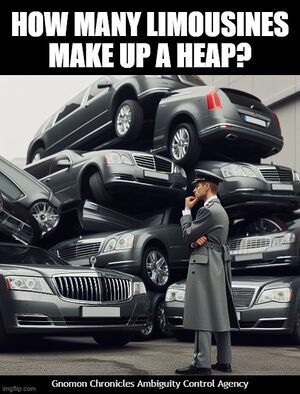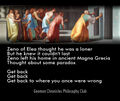How many limousines make up a heap?: Difference between revisions
No edit summary |
No edit summary |
||
| Line 42: | Line 42: | ||
=== Social media === | === Social media === | ||
* [https://twitter.com/GnomonChronicl1/status/1681280090481500161 Post] @ Twitter (18 July 2023) - Typo | |||
* [https://twitter.com/GnomonChronicl1/status/1654261579628642305 Post] @ Twitter (4 May 2023) | * [https://twitter.com/GnomonChronicl1/status/1654261579628642305 Post] @ Twitter (4 May 2023) | ||
Latest revision as of 05:30, 18 July 2023
The Limousines (/ˈlɪməziːn/ or /lɪməˈziːn/) paradox (often expressed as How many limousines make up a heap?) is a paradox that results from vague predicates.
Discussion
A typical formulation involves a heap of limousines, from which limousines are removed individually. With the assumption that removing a single limousine does not cause a heap to become a non-heap, the paradox is to consider what happens when the process is repeated enough times that only one limousine remains: is it still a heap? If not, when did it change from a heap to a non-heap?
Background
Context: "How many cars do you need to own before it's considered a fleet?"
One will suffice— if the driver is wearing livery.
In the News
"Get Back (Zeno of Elea)" is a song by The Beatles.
Tire Fires of the Rich and Famous is an American television series featuring the extravagant tire fires of wealthy entertainers, athletes, socialites, and magnates.
Fiction cross-reference
- Get Back (Zeno of Elea)
- Gnomon algorithm
- Gnomon Chronicles
- Salmonella fetishism
- Tire Fires of the Rich and Famous
- Wealth
Nonfiction cross-reference
External links
- Sorites paradox @ Wikipedia



